View in other NatureServe Network Field Guides
NatureServe
Montana
Utah
Wyoming
Idaho
Wisconsin
British Columbia
South Carolina
Yukon
California
New York
Narrowleaf Peatmoss - Sphagnum angustifolium
General Description
Plants: Dense to open growing, thin, the stems somewhat firm (FNA 2007); yellow-green (Vitt 1988), green, light yellow to ochre or brown; capitulum flat and conspicuously 5-rayed in plants growing in wetter habitats, and more rounded in plants from drier habitats (FNA 2007).
Stems and Stem Leaves: Stems light green to light brown, frequently with pink areas. Stem leaves deltoid with 2 or 3 sides about the same length, usually flattened against the stem, up to 0.8 mm, with the apex acute to broadly angled (FNA 2007).
Branches and Branch Leaves: Branches are straight or may be a little rounded, typically 5-ranked, dimorphic, each bunch with 2 spreading and 2-3 drooping branches, the spreading branches broader and firmer than the pendent ones. Branch leaves lance-shaped or broader a little above the base, 0.8-1 mm in length (a bit longer than the stem leaves), those on plants of wetter habitats somewhat wavy and curved back and under, those from drier areas not wavy and less recurved; margins smooth; upper leaves only slightly longer than lower leaves. (FNA 2007).
Stem and Stem Leaf Cells: Stem cortical cells not differentiated from the cylinder. Stem leaf cells lacking fibrils and divisions (nonseptate) (FNA 2007).
Branch and Branch Leaf Cells: Branch stem cortex expanded with 1-pored, short-necked retort cells that are proximally pink to deep pink. Branch leaf hyaline cells display 1 (sometimes 2-3) pores at their distal ends on the convex leaf surface, the cell walls showing thin areas at their ends and in the angles on the concave leaf surface; green (chlorophyllous) cells deltoid in X-section, more exposed on the convex surface, sealed away from the concave surface, the end walls of the cells not of great depth (FNA 2007).
Diagnostic Characteristics
The stem leaf’s small size, deltoid shape with obtuse tips, and flattened-against-the-stem habit distinguish this species from other ones in section Cuspidata (FNA 2007).
Range Comments
North American Range
Found in AK and most Canadian provinces and territories (except PE and NU), in the northeastern states s to NC, inland to MO, IL, WI, extending w in the upper tier of states to WA, also WY, CO, UT, OR and CA; Greenland and Eurasia (FNA 2007). Known in Montana from Beaverhead, Flathead, Granite, Lincoln, and Missoula Counties (Elliott 2016).
Observations in Montana Natural Heritage Program Database
Number of Observations: 24
(Click on the following maps and charts to see full sized version)
Map Help and Descriptions
Relative Density
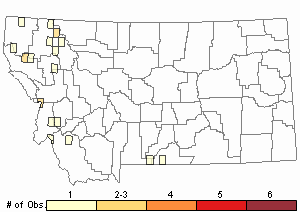
Recency
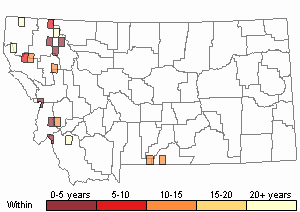
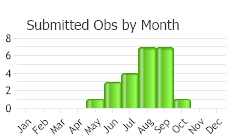
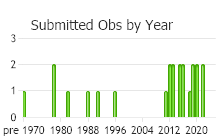
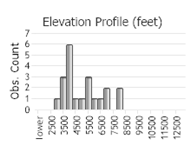 (Observations spanning multiple months or years are excluded from time charts)
(Observations spanning multiple months or years are excluded from time charts)
Habitat
In wet peat (Elliott 2016) in low- to mineral-rich fens, sedge fens, exposed bogs, forming blankets, floating carpets or hillocks (FNA 2007), filling in cavities but remaining above the water table (Vitt 1988). Elevation: low to high (FNA 2007).
Reproductive Characteristics
Diocious. Sporophytes common. Capsules under 2 mm in length; pseudostomata few (FNA 2007).
Stewardship Responsibility
References
- Literature Cited AboveLegend:
 View Online Publication
View Online Publication Elliott, J.C. and A.K. Pipp. 2018. A Checklist of Montana Mosses (1880-2018). Updated 3 January, 2020. Montana Natural Heritage Program, Helena, Montana. 73 pp.
Elliott, J.C. and A.K. Pipp. 2018. A Checklist of Montana Mosses (1880-2018). Updated 3 January, 2020. Montana Natural Heritage Program, Helena, Montana. 73 pp.
- Additional ReferencesLegend:
 View Online Publication
View Online Publication
Do you know of a citation we're missing? Elliot, J. C. 1993. Second checklist of Montana mosses. Unpublished report. U.S. Forest Service, Region 1. Missoula, MT. 45 pp.
Elliot, J. C. 1993. Second checklist of Montana mosses. Unpublished report. U.S. Forest Service, Region 1. Missoula, MT. 45 pp. Lawton, E. 1971. Keys for the Identification of the Mosses on the Pacific Northwest. Reprinted from 'Moss Flora of the Pacific Northwest'. Published as Supplement No. 2 of the Journal of the Hattori Botanical Laboratory. Nichinan, Miyazaki, Japan. 66 pp.
Lawton, E. 1971. Keys for the Identification of the Mosses on the Pacific Northwest. Reprinted from 'Moss Flora of the Pacific Northwest'. Published as Supplement No. 2 of the Journal of the Hattori Botanical Laboratory. Nichinan, Miyazaki, Japan. 66 pp. Lawton, E. 1971. Moss Flora of the Pacific Northwest. Hattori Botanical Laboratory. Japan: Yamabuki-cho, Shinjuku-ku, Tokyo. 362 pages plus appendices.
Lawton, E. 1971. Moss Flora of the Pacific Northwest. Hattori Botanical Laboratory. Japan: Yamabuki-cho, Shinjuku-ku, Tokyo. 362 pages plus appendices.
- Web Search Engines for Articles on "Narrowleaf Peatmoss"





